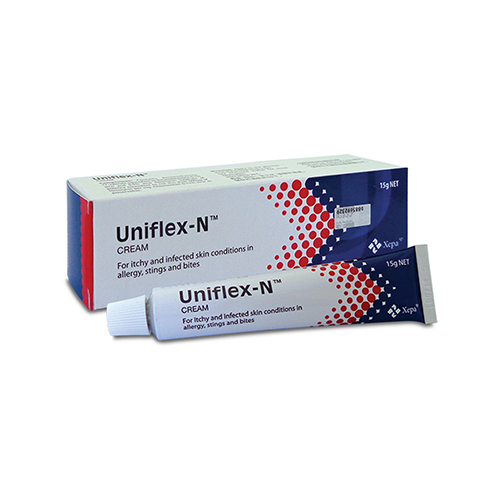
UNIFLEX – N Cream
Therapeutic Class
Antibacterial agent with Corticosteriods
Indications
For the relief of the inflammatory manifestations of corticosteroid-responsive dermatoses such as in eczema, infantile eczema, atopic dermatitis, dermatitis herpetiformis, contact dermatitis, seborrhoeic dermatitis, neurodermatitis, some form of psoriasis and intertrigo.
Chemical Composition
Betamethasone 17-valerate equivalent to
Betamethasone 0.1% w/w in a non-greasy water miscible cream.
Chlorocresol 0.15% w/w as preservative.
Packaging
15 g / Tube
Dosage & Administration
Apply sparingly onto the affected area 2 to 3 times a day. When a favourable response is obtained, reduce application gradually and eventually discontinue.
Contraindications
Unless under medical supervision, Uniflex should not be used for rosacea or on areas around the mouth. Uniflex should not be used for acne, viral skin infections e.g. herpes simplex (cold sores) and chicken pox; fungal infections e.g. candidiasis; bacterial infections; in patients with a history of sensitivity to any of its components. Do not use in children under one year of age, including dermatitis and napkin eruptions.
Warning & Precautions
If irritation develops with the use of Uniflex-N, treatment should be discontinued and appropriate therapy instituted. Prolonged topical therapy should be avoided where possible. Any of the side effects reported following systemic use of corticosteroids, including adrenal suppression, may also occur following their topical use, especially in children and infants. Systemic absorption will be increased if extensive body surfaces are treated or if occlusive dressing is used. Although topical steroids have not been reported to have adverse effect on human pregnancy, their safe use in pregnant women has not been absolutely established. In laboratory animals, topical administration of steroids has been associated with foetal deformities. Therefore, corticosteroids should not be used in large amounts or for prolonged periods in pregnant women.
Side Effects
Uniflex is generally well tolerated when used for short durations and over small areas. If application of more than 100 g per week is used, betamethasone ester, being a potent corticosteroid, is likely to produce the severe side-effects associated with steroid use such as pituitary-adrenal-axis suppression. As with other topical corticosteroids, prolonged use of large amount or treatment of extensive areas can result in sufficient systemic absorption to produce the features of hypercorticism and suppression of HPA axis. These effects are likely to occur in infants and children, and if occlusive dressings is used. Local side-effects may include spread of local infections, thinning of the skin, irreversible striae atrophicae, increased hair growth, acne, mild depigmentation and growth of vellus hair and perioral dermatitis in young women.
Drug Interaction
Topical application of Uniflex is not likely to produce significant drug interactions. Concurrent use of barbiturates, phenytoin, or rifampicin may enhance the metabolism and decrease the effect of corticosteroids.

